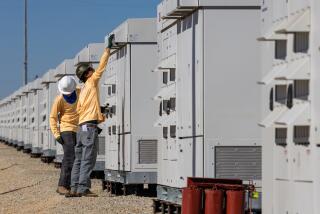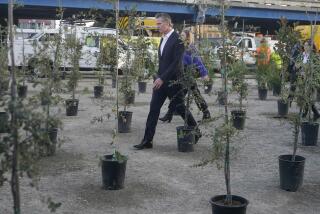Gov. Brown pushes 12-gigawatt clean-power goal
California wants 12 gigawatts of electricity from local clean power sources, such as rooftop solar panels, small wind turbines and fuel cells, by 2020, Gov. Jerry Brown said at a gathering of more than 200 energy experts at UCLA that he convened Monday. Twelve gigawatts is enough to power roughly 3 million homes.
But Brown was short on details about the mechanics of reaching that goal.
“It’s going to take all manner of investment, risk taking and collaboration,” he said.
At the moment, the state’s renewable energy portfolio is laden with large wind and solar farms sprawling over remote deserts and mountains. More are being built to meet a state mandate signed by Brown this spring for 33% of California’s power to come from clean sources by the end of the decade.
But delivering the electricity to city-bound customers requires expensive and often inefficient transmission infrastructure that can take years to build. Such projects also draw accusations of encroachment from environmentalists and nearby residents.
Plans to scatter smaller renewable energy sources in urban areas — a tactic known as distributed generation — are “smart, no-brainer solutions,” said Bernadette Del Chiaro, director of clean energy programs for advocacy group Environment California.
Localized power production atop homes and businesses takes little time to set up — about two days for solar panels, according to Lyndon Rive, chief executive of installation giant SolarCity. And according to fellow speaker David Crane, CEO of NRG Energy Inc., such projects help create green jobs in local neighborhoods.
Still, distributed generation could be a long time coming. The state lags behind competitors such as Germany, whose buildings are often plastered with solar panels, Brown said.
Federal agencies have stymied efforts to finance green home improvements, such as the Property Assessed Clean Energy program. And streamlining the permitting process for clean technologies will be a major undertaking involving swarms of county and city governments.
Meanwhile, incentives to encourage renewable energy installations may be scaled back as local officials face deficits and cutbacks.
“This is tens of thousands of little decisions,” Brown said. “The distribution is its strength and also its challenge.”
Brown’s 12-gigawatt goal is far from the first attempt at widespread distributed generation. His predecessor, Arnold Schwarzenegger, championed a Million Solar Roofs program that sought to create three gigawatts of consumer-produced solar electricity by 2016.
A local coalition led by the Los Angeles Business Council is pushing a 10-year plan to install 600 megawatts of rooftop solar power in Los Angeles, which could power 137,000 average homes.
Last month, the federal Energy Department guaranteed part of a $1.4-billion loan for Project Amp, an effort to install 733 megawatts of solar panels on industrial buildings around the country, starting in Southern California.
More to Read
Inside the business of entertainment
The Wide Shot brings you news, analysis and insights on everything from streaming wars to production — and what it all means for the future.
You may occasionally receive promotional content from the Los Angeles Times.











